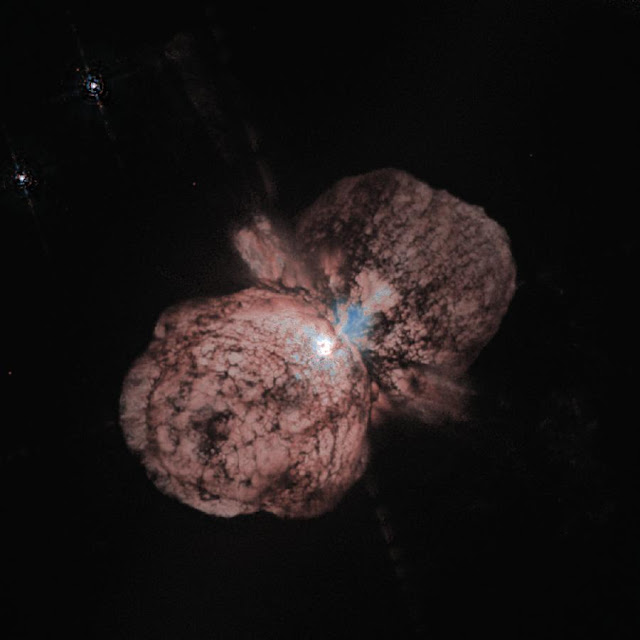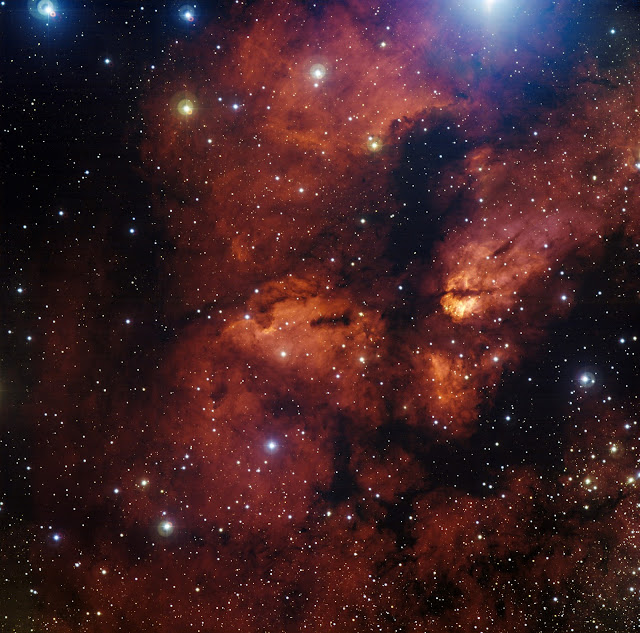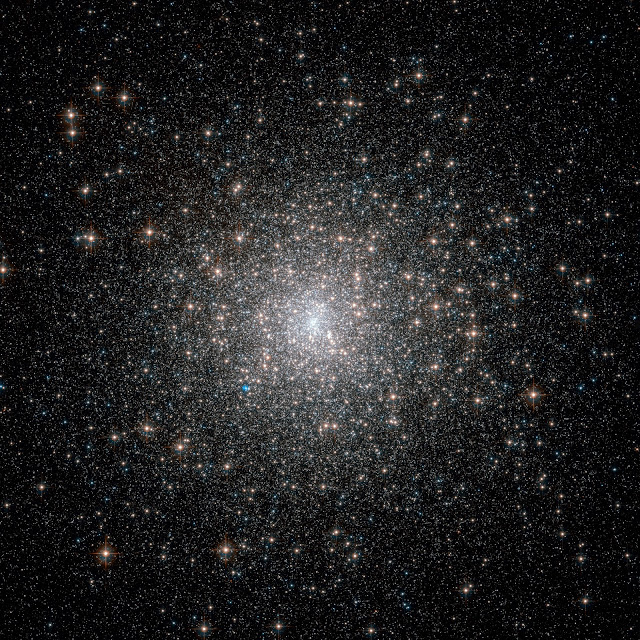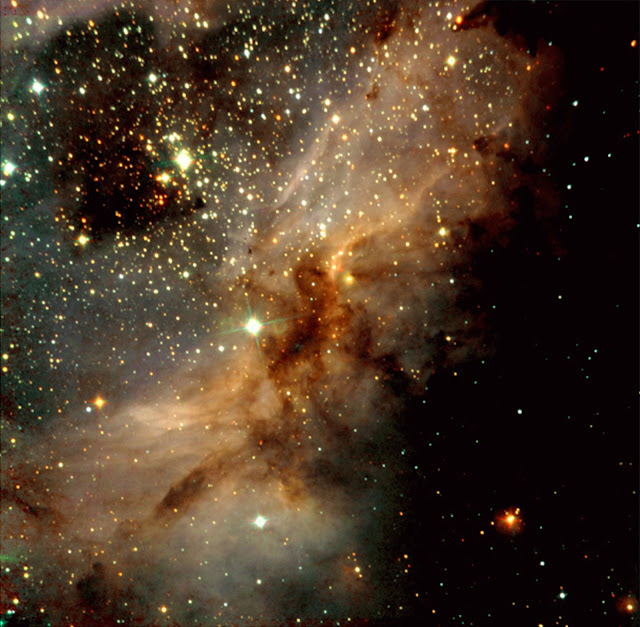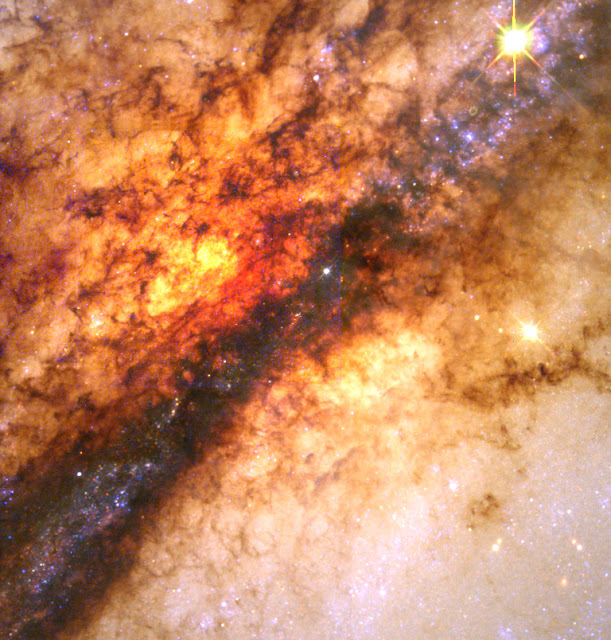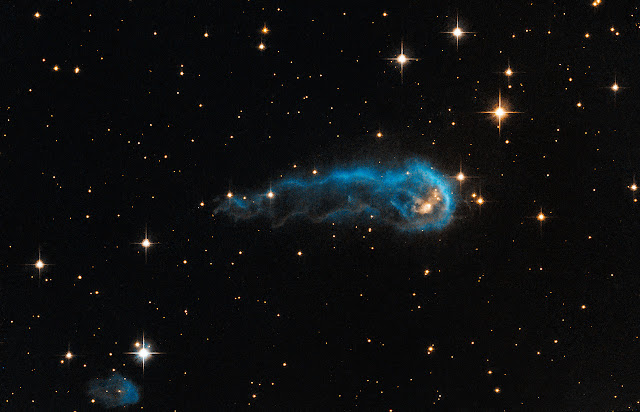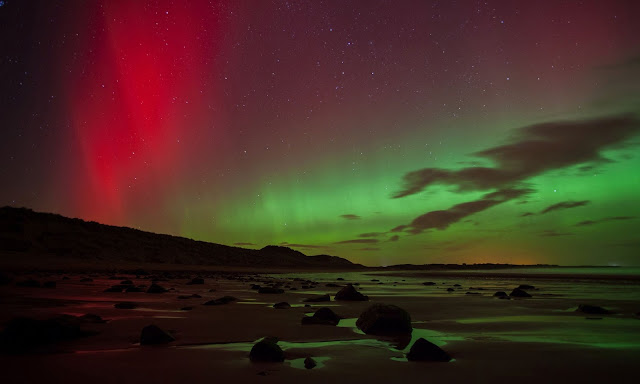Blog about Earth and Astronomy - Scientific Pictures and News about the Universe
- | Home Page |
- Best Posts
- Best Pictures
- History of the Earth
- Solar System
- Earth from Space
- ISS
- Milky Way
- Auroras
- Eclipses
- Clouds
- Lightnings
- Volcanoes
- Meteors
- Moon
- Sun
- Universe
- Nebulae
- Galaxies
- Live ISS
- Live Sun
- Aurora Forecast
- Earth Day 2018
- HD Wallpapers
- | SUBSCRIBE |
- | JOIN |
- | Send feedback |
- | Contact |
December 31, 2016
December 30, 2016
Molecular Cloud Cepheus B
- Cepheus B is a cloud of molecular hydrogen, a place where stars are known to form
- Researchers used Chandra and Spitzer to study this cloud, which is relatively close at 2,400 light years away
- The combined data reveal that massive stars may trigger star formation more often than previously thought
This composite image, combining data from the Chandra X-ray Observatory and the Spitzer Space Telescope shows the molecular cloud Cepheus B, located in our Galaxy about 2,400 light years from the Earth. A molecular cloud is a region containing cool interstellar gas and dust left over from the formation of the galaxy and mostly contains molecular hydrogen. The Spitzer data, in red, green and blue shows the molecular cloud (in the bottom part of the image) plus young stars in and around Cepheus B, and the Chandra data in violet shows the young stars in the field.
The Chandra observations allowed the astronomers to pick out young stars within and near Cepheus B, identified by their strong X-ray emission. The Spitzer data showed whether the young stars have a so-called "protoplanetary" disk around them. Such disks only exist in very young systems where planets are still forming, so their presence is an indication of the age of a star system.
These data provide an excellent opportunity to test a model for how stars form. The new study suggests that star formation in Cepheus B is mainly triggered by radiation from one bright, massive star (HD 217086) outside the molecular cloud. According to the particular model of triggered star formation that was tested -- called the radiation-driven implosion (RDI) model -- radiation from this massive star drives a compression wave into the cloud triggering star formation in the interior, while evaporating the cloud's outer layers.
The labeled version of the image (rollover the image above) shows important regions in and around Cepheus B. The "inner layer" shows the Cepheus B region itself, where the stars are mostly about one million years old and about 70-80% of them have protoplanetary disks. The "intermediate layer" shows the area immediately next to Cepheus B, where the stars are two to three million years old and about 60% of them have disks, while in the "outer layer" the stars are about three to five million years old and about 30% of them have disks. This increase in age as the stars are further away from Cepheus B is exactly what is predicted from the RDI model of triggered star formation.
Different types of triggered star formation have been observed in other environments. For example, the formation of our solar system was thought to have been triggered by a supernova explosion, In the star-forming region W5, a "collect-and-collapse" mechanism is thought to apply, where shock fronts generated by massive stars sweep up material as they progress outwards. Eventually the accumulated gas becomes dense enough to collapse and form hundreds of stars. The RDI mechanism is also thought to be responsible for the formation of dozens of stars in W5. The main cause of star formation that does not involve triggering is where a cloud of gas cools, gravity gets the upper hand, and the cloud falls in on itself.
Image Credit: X-ray (NASA/CXC/PSU/K. Getman et al.); IR (NASA/JPL-Caltech/CfA/J. Wang et al.)
Explanation from: http://chandra.harvard.edu/photo/2009/cepb/
Posted by
Earth
at
10:17 AM
1 comment:
The Expansion of Eta Carinae Debris
The massive star Eta Carinae (almost hidden in the center) underwent a giant explosion some 150 years ago. The outburst spread the material that is visible today in this very sharp Hubble image. Even though Eta Carinae is more than 8,000 light-years away, structures only 15 thousand million kilometre across (about the diameter of our solar system) can be distinguished. Dust lanes, tiny condensations, and strange radial streaks al appear with unprecedented clarity.
A huge, billowing pair of gas and dust clouds are captured in this stunning Hubble Space Telescope image of the supermassive star Eta Carinae.
Image Credit: Jon Morse (University of Colorado), and NASA/ESA
Explanation from: https://www.spacetelescope.org/images/opo9623a/
Posted by
Earth
at
10:12 AM
No comments:
Star Cluster RCW 38
The wider region surrounding the star cluster RCW 38, located about 5,500 light years away in the direction of the constellation Vela (the Sails). RCW 38 is an "embedded" cluster, in that the nascent cloud of dust and gas still envelops its stars. There, young, titanic stars bombard fledgling suns and planets with powerful winds and large amount of light, helped in their devastating task by short- lived, massive stars that explode as supernovae. In some cases, this energetic onslaught cooks away the matter that may eventually form new planetary systems. Scientists think that our own Solar System emerged from such a dramatic environment.
This image was obtained with the Wide Field Imager instrument on the MPG/ESO 2.2-metre telescope at La Silla, using data collected through four filters (B, V, R and H-alpha). The field of view is 30 arcminutes.
Image Credit: ESO
Explanation from: http://www.eso.org/public/images/eso0929c/
Posted by
Earth
at
10:09 AM
No comments:
Globular Cluster Messier 15
The dazzling stars in Messier 15 look fresh and new in this image from the NASA/Hubble Space Telescope, but they are actually all roughly 13 billion years old, making them some of the most ancient objects in the Universe.
Messier 15 is a globular cluster — a spherical conglomeration of old stars that formed together from the same cloud of gas, found in the outer reaches of the Milky Way in a region known as the halo and orbiting the Galactic Centre. This globular lies about 35 000 light-years from the Earth, in the constellation of Pegasus (The Flying Horse).
Messier 15 is one of the densest globulars known, with the vast majority of the cluster’s mass concentrated in the core. Astronomers think that particularly dense globulars, like this one, underwent a process called core collapse, in which gravitational interactions between stars led to many members of the cluster migrating towards the centre.
Messier 15 is also the first globular cluster known to harbour a planetary nebula, and it is still one of only four globulars known to do so. The planetary nebula, called Pease 1, can be seen in this image as a small blue blob to the lower left of the globular’s core.
This picture was put together from images taken with the Wide Field Channel of Hubble's Advanced Camera for Surveys. Images through yellow/orange (F606W, coloured blue) and near-infrared (F814W, coloured red) filters were combined. The total exposure times were 535 s and 615 s respectively and the field of view is 3.4 arcminutes across.
Image Credit: ESA/Hubble & NASA
Explanation from: https://www.spacetelescope.org/images/potw1107a/
Posted by
Earth
at
10:07 AM
No comments:
The centre of the Milky Way
The central parts of our Galaxy, the Milky Way, as observed in the near-infrared with the NACO instrument on ESO's Very Large Telescope. By following the motions of the most central stars over more than 16 years, astronomers were able to determine the mass of the supermassive black hole that lurks there.
Image Credit: ESO/S. Gillessen et al.
Posted by
Earth
at
9:51 AM
2 comments:
December 29, 2016
Lenticular Galaxy NGC 4762
This spectacular image was captured by the NASA/ESA Hubble Space Telescope's Advanced Camera for Surveys (ACS). The bright streak slicing across the frame is an edge-on view of galaxy NGC 4762, and a number of other distant galaxies can be seen scattered in the background.
NGC 4762 lies about 58 million light-years away in the constellation of Virgo (The Virgin). It is part of the Virgo Cluster, hence its alternative designation of VCC 2095 for Virgo Cluster Catalogue entry. This catalogue is a listing of just over 2000 galaxies in the area of the Virgo Cluster. The Virgo Cluster is actually prominently situated, and lies at the centre of the larger Virgo supercluster, of which our galaxy group, the Local Group, is a member.
Previously thought to be a barred spiral galaxy, NGC 4762 has since been found to be a lenticular galaxy, a kind of intermediate step between an elliptical and a spiral. The edge-on view that we have of this particular galaxy makes it difficult to determine its true shape, but astronomers have found the galaxy to consist of four main components — a central bulge, a bar, a thick disc and an outer ring.
The galaxy's disc is asymmetric and warped, which could potentially be explained by NGC 4762 violently cannibalising a smaller galaxy in the past. The remains of this former companion may then have settled within NGC 4762's disc, redistributing the gas and stars and so changing the disc's morphology.
NGC 4762 also contains a Liner-type Active Galactic Nucleus, a highly energetic central region. This nucleus is detectable due to its particular spectral line emission, which acts as a type of "atomic fingerprint", allowing astronomers to measure the composition of the region.
Image Credit: ESA/Hubble & NASA
Explanation from: https://www.spacetelescope.org/images/potw1443a/
Posted by
Earth
at
10:13 AM
No comments:
Saturn's Rings
Saturn's softly glowing rings shine in scattered sunlight.
The B ring presents a remarkable difference in brightness between the near and far arms (bottom and top of the image, respectively). The strong variation in brightness could be due to the presence of wake-like features in the B ring.
This view looks toward the unilluminated side of the rings from about 5 degrees above the ringplane. Images taken using red, green and blue spectral filters were combined to create this natural color view. The images were acquired at a distance of approximately 574,000 kilometers (357,000 miles) from Saturn. At the center of the image, the Sun-ring-spacecraft, or phase, angle is 114 degrees, and the image scale is 34 kilometers (21 miles) per pixel in the radial, or outward from Saturn, direction.
Image Credit: NASA/JPL/Space Science Institute
Explanation from: http://photojournal.jpl.nasa.gov/catalog/PIA09860
Posted by
Earth
at
10:09 AM
No comments:
HII Region Sh2-284
NASA's Wide-field Infrared Survey Explorer, or WISE, captured this image of a star-forming cloud of dust and gas located in the constellation of Monoceros. The nebula, commonly referred to as Sh2-284, is relatively isolated at the very end of an outer spiral arm of our Milky Way galaxy. In the night sky, it's located in the opposite direction from the center of the Milky Way.
Perhaps the most interesting features in Sh2-284 are what astronomer call "elephant trunks." Elephant trunks are monstrous pillars of dense gas and dust. The most famous examples of are the "Pillars of Creation," found in an iconic image of the Eagle nebula from NASA's Hubble Space Telescope. In this WISE image, the trunks are seen as small columns of gas stretching towards the center of the void in Sh2-284, like little green fingers with yellow fingernails. The most notable one can be seen on the right side of the void at about the 3 o'clock position. It appears as a closed hand with a finger pointing towards the center of the void. That elephant trunk is about 7 light-years long.
Deep inside Sh2-284 resides an open star cluster, called Dolidze 25, which is emitting vast amounts of radiation in all directions, along with stellar winds. These stellar winds and radiation are clearing out a cavern inside the surrounding gas and dust, creating the void seen in the center. The bright green wall surrounding the cavern shows how far out the gas has been eroded. However, some sections of the original gas cloud were much denser than others, and they were able to resist the erosive power of the radiation and stellar winds. These pockets of dense gas remained and protected the gas "downwind" from them, leaving behind the elephant trunks. These pillars can also be thought of as rising like stalagmites from the cavern walls.
The Sh2-284 nebula is classified as an HII region. HII regions go hand in hand with star formation, and indeed the stars in the central Dolidze 25 cluster have just recently formed. They're hot, young, bright stars, with ages ranging from 1.5 to 13 million years -- infants by astronomical standards. In comparison, the sun is about 4.6 billion years old.
The colors used in this image represent specific wavelengths of infrared light. Blue and cyan (blue-green) represent light emitted at wavelengths of 3.4 and 4.6 microns, which is predominantly from stars. Green and red represent light from 12 and 22 microns, respectively, which is mostly emitted by dust.
Image Credit: NASA/JPL-Caltech/UCLA
Explanation from: http://photojournal.jpl.nasa.gov/catalog/PIA13904
Posted by
Earth
at
9:55 AM
No comments:
Supernova Remnant RCW 86
This supernova remnant is the remains of an exploded star that may have been witnessed by Chinese astronomers almost 2,000 years ago. Modern telescopes have the advantage of observing this object in light that is completely invisible to the unaided human eye. This image combines X-rays from Chandra (pink and blue) along with visible emission from hydrogen atoms in the rim of the remnant, observed with the 0.9-m Curtis Schmidt telescope at the Cerro Tololo Inter-American Observatory (yellow).
Image Credit: X-ray: NASA/CXC/MIT/D.Castro et al, Optical: NOAO/AURA/NSF/CTIO
Explanation from: http://chandra.si.edu/photo/2015/iyl/more.html
Posted by
Earth
at
9:44 AM
No comments:
Large Magellanic Cloud Galaxy in the Infrared
This vibrant image from NASA's Spitzer Space Telescope shows the Large Magellanic Cloud, a satellite galaxy to our own Milky Way galaxy.
The infrared image, a mosaic of more than 100,000 individual tiles, offers astronomers a unique chance to study the lifecycle of stars and dust in a single galaxy. Nearly one million objects are revealed for the first time in this Spitzer view, which represents about a 1,000-fold improvement in sensitivity over previous space-based missions. Most of the new objects are dusty stars of various ages populating the Large Magellanic Cloud; the rest are thought to be background galaxies.
The blue color in the picture, seen most prominently in the central bar, represents starlight from older stars. The chaotic, bright regions outside this bar are filled with hot, massive stars buried in thick blankets of dust. The red clouds contain cooler interstellar gas and molecular-sized dust grains illuminated by ambient starlight.
The Large Magellanic Cloud, located 160,000 light-years from Earth, is one of a handful of dwarf galaxies that orbit our own Milky Way. It is approximately one-third as wide as the Milky Way, and, if it could be seen in its entirety, would cover the same amount of sky as a grid of about 480 full moons. About one-third of the whole galaxy can be seen in the Spitzer image.
This picture is a composite of infrared light captured by Spitzer's infrared array camera. Light with wavelengths of 8 and 5.8 microns is red and orange: 4.5-micron light is green; and 3.6-micron light is blue.
Image Credit: NASA/JPL-Caltech/M. Meixner (STScI) & the SAGE Legacy Team
Explanation from: http://www.spitzer.caltech.edu/images/1666-ssc2006-17a1-Large-Magellanic-Cloud-in-the-Infrared
Posted by
Earth
at
9:39 AM
No comments:
December 28, 2016
Elliptical Galaxy NGC 2865
This NASA/ESA Hubble Space Telescope image shows an elliptical galaxy called NGC 2865. It lies just over 100 million light-years away from us in the constellation of Hydra — The Sea Serpent — and was discovered in 1835 by astronomer John Herschel.
Elliptical galaxies are usually filled with old, dying stars. NGC 2865, however, is relatively youthful and dynamic, with a rapidly rotating disc full of young stars and metal-rich gas. For an elliptical galaxy it contains an unusually high number of young stars — suggesting that a galaxy-wide starburst took place about one billion years ago.
The starburst itself was induced by a merger between a spiral galaxy, similar to our galaxy, the Milky Way, and an elliptical galaxy some three times more massive — the progenitor galaxy of NGC 2865. The new gas from the spiral galaxy revitalised the dying population of old stars in the elliptical galaxy, and several new generations of stars were born.
The faint halo surrounding the galaxy, visible in this image, is also a result of this merger. It consists of cold gas that was ripped away from the spiral galaxy during the merging process. The gas now forms an almost closed shell around its host galaxy.
Explanation from: https://www.spacetelescope.org/images/potw1515a/
Posted by
Earth
at
11:39 PM
1 comment:
Star-Forming Region Messier 17
This is a near-infrared, colour-coded composite image of a sky field in the south-western part of the galactic star-forming region Messier 17.
In this image, young and heavily obscured stars are recognized by their red colour. Bluer objects are either foreground stars or well-developed massive stars whose intense light ionizes the hydrogen in this region.
The diffuse light that is visible nearly everywhere in the photo is due to emission from hydrogen atoms that have (re-)combined from protons and electrons. The dark areas are due to obscuration of the light from background objects by large amounts of dust — this effect also causes many of those stars to appear quite red.
A cluster of young stars in the upper-left part of the photo, so deeply embedded in the nebula that it is invisible in optical light, is well visible in this infrared image.
Explanation from: https://www.eso.org/public/images/eso0030a/
Posted by
Earth
at
11:36 PM
No comments:
Centaurus A
A close-up high resolution Wide Field Planetary Camera 2 image of the dramatic dust disk which is thought to be the remnant of a smaller spiral galaxy that merged with the large elliptical galaxy. The shock of the collision compressed interstellar gas, precipitating a flurry of star formation and giving the material a fleecy pattern. Dark filaments of dust mixed with cold hydrogen gas are silhouetted against the incandescent yellow-orange glow from stars behind it.
Image Credit: E.J. Schreier, (STScI) and NASA/ESA
Explanation from: http://www.spacetelescope.org/images/opo9814e/
Posted by
Earth
at
11:31 PM
No comments:
Paranal Observatory
Gaze up at the night sky from ESO's Paranal Observatory in Chile, and you will be greeted with a stunning view like this one. Flecks of blue, orange, red; each a different star, galaxy, nebula, or more, together forming a sparkling sky overhead. Astronomers peer at this beautiful backdrop, trying to unravel the mysteries of the Universe.
To do this, they use telescopes like the ones shown here, the VLT Auxiliary Telescopes. This image shows three of the four moveable units that feed light into the Very Large Telescope Interferometer, the world's most advanced optical instrument. Combining to form one larger telescope, they are greater than the sum of their parts: they reveal details that would be visible with a telescope as large as the distance between them.
Image Credit: Y. Beletsky (LCO)/ESO
Explanation from: https://www.eso.org/public/images/potw1401a/
Posted by
Earth
at
11:26 PM
No comments:
Emission Nebula NGC 248
The sheer observing power of the NASA/ESA Hubble Space Telescope is rarely better illustrated than in an image such as this. This glowing pink nebula, named NGC 248, is located in the Small Magellanic Cloud, just under 200 000 light-years away and yet can still be seen in great detail.
Our home galaxy, the Milky Way, is part of a collection of galaxies known as the Local Group. Along with the Andromeda Galaxy, the Milky Way is one of the Group’s most massive members, around which many smaller satellite galaxies orbit. The Magellanic Clouds are famous examples, which can easily be seen with the naked eye from the southern hemisphere.
Within the smaller of these satellite galaxies, the Small Magellanic Cloud, the NASA/ESA Hubble Space Telescope captured two festive-looking emission nebulae, conjoined so they appear as one. Intense radiation from the brilliant central stars is causing hydrogen in the nebulae to glow pink.
Together the nebulae are called NGC 248. They were discovered in 1834 by the astronomer Sir John Herschel. NGC 248 is about 60 light-years long and 20 light-years wide. It is among a number of glowing hydrogen nebulae in the Small Magellanic Cloud, which lies in the southern constellation of Tucana (The Toucan), about 200 000 light-years away.
The nebula was observed as part of a Hubble survey, the Small Magellanic cloud Investigation of Dust and Gas Evolution (SMIDGE). In this survey astronomers are using Hubble to probe the Small Magellanic Cloud to understand how its dust — an important component of many galaxies and related to star formation — is different from the dust in the Milky Way.
Thanks to its relative proximity, the Small Magellanic Cloud is a valuable target. It also turns out to have only between a fifth and a tenth of the amount of heavy elements that the Milky Way has, making the dust similar to what we expect to see in galaxies in the earlier Universe.
This allows astronomers to use it as a cosmic laboratory to study the history of the Universe in our cosmic backyard. These observations also help us to understand the history of our own galaxy as most of the star formation happened earlier in the Universe, at a time when the percentage of heavy elements in the Milky Way was much lower than it is now.
The data used in this image were taken with Hubble’s Advanced Camera for Surveys in September 2015.
Image Credit: NASA, ESA, STScI, K. Sandstrom (University of California, San Diego), and the SMIDGE team
Explanation from: https://www.spacetelescope.org/news/heic1623/
Posted by
Earth
at
11:21 PM
1 comment:
December 27, 2016
Star-Forming Region N11
This spectacular NASA/ESA Hubble Space Telescope image — one of the largest ever released of a star-forming region — highlights N11, part of a complex network of gas clouds and star clusters within our neighbouring galaxy, the Large Magellanic Cloud. This region of energetic star formation is one of the most active in the nearby Universe.
Image Credit: NASA/ESA
Posted by
Earth
at
11:50 PM
No comments:
Planetary Nebula NGC 2818
The unique planetary nebula NGC 2818 is nested inside the open star cluster NGC 2818A. Both the cluster and the nebula reside over 10 000 light-years away, in the southern constellation Pyxis (the Compass).
NGC 2818 is one of very few planetary nebulae in our galaxy located within an open cluster. Open clusters, in general, are loosely bound and they disperse over hundreds of millions of years. Stars that form planetary nebulae typically live for billions of years. Hence, it is rare that an open cluster survives long enough for one of its members to form a planetary nebula. This open cluster is particularly ancient, estimated to be nearly one billion years old.
The spectacular structure of NGC 2818 (also known as PLN 261+8.1) contains the outer layers of a sun-like star that were sent off into interstellar space during the star' s final stages of life. These glowing gaseous shrouds were shed by the star after it ran out of fuel to sustain the nuclear reactions in its core.
Planetary nebulae can have extremely varied structures. NGC 2818 has a complex shape that is difficult to interpret. However, because of its location within the cluster, astronomers have access to information about the nebula, such as its age and distance, that might not otherwise be known.
Planetary nebulae fade away gradually over tens of thousands of years. The hot, remnant stellar core of NGC 2818 will eventually cool off for billions of years as a white dwarf. Our own Sun will undergo a similar process, but not for another 5 billion years or so.
This Hubble image was taken in November 2008 with the Wide Field Planetary Camera 2. The colours in the image represent a range of emissions coming from the clouds of the nebula: red represents nitrogen, green represents hydrogen, and blue represents oxygen.
Image Credit: NASA, ESA and the Hubble Heritage Team (STScI/AURA)
Explanation from: https://www.spacetelescope.org/images/ann0901a/
Posted by
Earth
at
11:44 PM
No comments:
Globular Cluster M4
Peering deep inside a cluster of several hundred thousand stars, the NASA/ESA Hubble Space Telescope uncovered the oldest burned-out stars in our Milky Way Galaxy. Located in the globular cluster M4, these small, dying stars - called white dwarfs - are giving astronomers a fresh reading on one of the biggest questions in astronomy: How old is the Universe? The ancient white dwarfs in M4 are about 12 to 13 billion years old. After accounting for the time it took the cluster to form after the big bang, astronomers found that the age of the white dwarfs agrees with previous estimates for the Universe's age.
Image Credit: NASA/ESA and H. Richer
Explanation from: https://www.spacetelescope.org/images/opo0210c/
Posted by
Earth
at
11:42 PM
2 comments:
Panoramic view of the WR 22 and Eta Carinae regions of the Carina Nebula
This spectacular panoramic view combines a new image of the field around the Wolf–Rayet star WR 22 in the Carina Nebula (right) with an earlier picture of the region around the unique star Eta Carinae in the heart of the nebula (left). The picture was created from images taken with the Wide Field Imager on the MPG/ESO 2.2-metre telescope at ESO’s La Silla Observatory in Chile.
Image Credit: ESO
Posted by
Earth
at
11:39 PM
No comments:
Bok Globule Barnard 68 (B68)
This photograph shows an unusual sky field in the Milky Way band. It is centred on one of the classical, dark globules, known as Barnard 68 (B68) after the American astronomer, Edward E. Barnard (1857 - 1923), who included it in a list of such objects, published in 1919.
It appears as a compact, opaque and rather sharply defined object against a rich, background star field. Even on this image that registers many faint stars in the area, not a single foreground star is observed. This is a clear sign that this globule must be relatively nearby. Interstellar clouds consist of gas and dust, including many molecules, some of which contain carbon atoms (i.e. organic).
For a long time considered to be "holes in the sky", molecular clouds are now known to be among the coolest objects in the Universe (the temperature is approx. 10 K, or -263 °C). Moreover, and most importantly, they are nurseries of stars and planets. It still remains a mystery how a dark cloud like Barnard 68 at some moment begins to contract and subsequently transforms itself into hydrogen-burning stars.
However, deep images of these clouds, such as this one obtained by FORS1 on VLT ANTU, may provide important clues. This small cloud seems to be in its very earliest phase of collapse. It has a diameter of only 7 light-months (approx. 0.2 pc) and it is located at a distance of about 500 light-years (160 pc) towards the southern constellation Ophiuchus (The Serpent-holder).
This three-colour composite was reproduced from one blue (B), one green-yellow (V) and one near-infrared (I) exposure that were obtained with VLT ANTU and FORS1 in the early morning of March 27, 1999.
It appears as a compact, opaque and rather sharply defined object against a rich, background star field. Even on this image that registers many faint stars in the area, not a single foreground star is observed. This is a clear sign that this globule must be relatively nearby. Interstellar clouds consist of gas and dust, including many molecules, some of which contain carbon atoms (i.e. organic).
For a long time considered to be "holes in the sky", molecular clouds are now known to be among the coolest objects in the Universe (the temperature is approx. 10 K, or -263 °C). Moreover, and most importantly, they are nurseries of stars and planets. It still remains a mystery how a dark cloud like Barnard 68 at some moment begins to contract and subsequently transforms itself into hydrogen-burning stars.
However, deep images of these clouds, such as this one obtained by FORS1 on VLT ANTU, may provide important clues. This small cloud seems to be in its very earliest phase of collapse. It has a diameter of only 7 light-months (approx. 0.2 pc) and it is located at a distance of about 500 light-years (160 pc) towards the southern constellation Ophiuchus (The Serpent-holder).
This three-colour composite was reproduced from one blue (B), one green-yellow (V) and one near-infrared (I) exposure that were obtained with VLT ANTU and FORS1 in the early morning of March 27, 1999.
Image Credit: ESO
Explanation from: https://www.eso.org/public/images/eso9924a/
Posted by
Earth
at
11:36 PM
No comments:
Protostar IRAS 20324+4057
This light-year-long knot of interstellar gas and dust resembles a caterpillar on its way to a feast. But the meat of the story is not only what this cosmic caterpillar eats for lunch, but also what's eating it. Harsh winds from extremely bright stars are blasting ultraviolet radiation at this "wanna-be" star and sculpting the gas and dust into its long shape.
The culprits are 65 of the hottest, brightest known stars, classified as O-type stars, located 15 light-years away from the knot, towards the right edge of the image. These stars, along with 500 less bright, but still highly luminous, B-type stars make up what is called the Cygnus OB2 association. Collectively, the association is thought to have a mass more than 30 000 times that of our Sun.
The caterpillar-shaped knot, called IRAS 20324+4057, is a protostar in a very early evolutionary stage. It is still in the process of collecting material from an envelope of gas surrounding it. However, that envelope is being eroded by the radiation from Cygnus OB2. Protostars in this region should eventually become young stars with final masses about one to ten times that of our Sun, but if the eroding radiation from the nearby bright stars destroys the gas envelope before the protostars finish collecting mass, their final masses may be reduced.
Spectroscopic observations of the central star within IRAS 20324+4057 show that it is still collecting material quite heavily from its outer envelope, hoping to bulk up. Only time will tell if the formed star will be a "heavy-weight" or a "light-weight" with respect to its mass.
This image of IRAS 20324+4057 is a composite of Hubble Advanced Camera for Surveys (ACS) data taken in green and infrared light in 2006, and ground-based hydrogen data from the Isaac Newton Telescope in 2003, as part of the IPHAS H-alpha survey. The object lies 4500 light-years away in the constellation of Cygnus (The Swan).
Image Credit: NASA, ESA, the Hubble Heritage Team (STScI/AURA), and IPHAS
Explanation from: https://www.spacetelescope.org/images/opo1335a/
Posted by
Earth
at
11:33 PM
No comments:
December 26, 2016
Spiral Galaxy NGC 4102
The NASA/ESA Hubble Space Telescope observes some of the most beautiful galaxies in our skies — spirals sparkling with bright stellar nurseries, violent duos ripping gas and stars away from one another as they tangle together, and ethereal irregular galaxies that hang like flocks of birds suspended in the blackness of space.
However, galaxies, like humans, are not all supermodels. This little spiral, known as NGC 4102, has a different kind of appeal, with its tightly-wound spiral arms and understated, but charming, appearance.
NGC 4102 lies in the northern constellation of Ursa Major (The Great Bear). It contains what is known as a LINER, or low-ionization nuclear emission-line region, meaning that its nucleus emits particular types of radiation — specifically, emission from weakly-ionised or neutral atoms of certain elements. Even in this sense, NGC 4102 is not special; around one third of all nearby galaxies are thought to be LINER galaxies.
Many LINER galaxies also contain intense regions of star formation. This is thought to be intrinsically linked to their centres but just why is still a mystery for astronomers — either the starbursts pour fuel inwards to fuel the LINERs, or this active central region triggers the starbursts. NGC 4102 does indeed contain a starburst region towards its centre, where stars are being created at a rate much more furious than in a normal galaxy. This star formation is taking place within a small rotating disc, around 1000 light-years in diameter and with a mass some three billion times the mass of the Sun.
Explanation from: https://www.spacetelescope.org/images/potw1448a/
Posted by
Earth
at
8:56 PM
1 comment:
Stellar Storm of Infrared Light
This infrared image taken by NASA's Wide-field Infrared Survey Explorer, or WISE, shows a star-forming cloud teeming with gas, dust and massive newborn stars. The inset reveals the very center of the cloud, a cluster of stars called NGC 3603. It was taken in visible light by NASA's Hubble Space Telescope.
WISE, which is surveying the whole sky in infrared light, is particularly sensitive to the warm dust that permeates star-forming clouds like this one. In this way, WISE complements visible-light observations.
The mission also complements Hubble and other telescopes by showing the 'big picture," providing context for more detailed observations. For example, the WISE picture here is 2,500 times larger than the Hubble inset. While the Hubble view shows the details of the hot young star cluster, the WISE picture shows the effects that this stellar powerhouse has on its neighborhood.
The cluster contains some of the most massive stars known. Winds and radiation from the stars are evaporating and dispersing the cloud material from which they formed, warming the cold dust and gas surrounding the central nebula. This greenish "halo" of warm cloud material is seen best by WISE due to its large field of view and improved sensitivity over past all-sky infrared surveys.
These WISE observations provide circumstantial evidence that the massive stars in the center of the cluster triggered the formation of younger stars in the halo, which can be seen as red dots. The dust at the center of the cluster is very hot, producing copious amounts of infrared light, which results in the bright, yellow cores of the nebulosity.
Ultimately, this turbulent region will be blasted apart by supernova explosions. Other star-forming clouds in the Milky Way have experienced such eruptions, as evidenced by their pockmarked clouds of expanding cavities and bubbles.
Massive star clusters like this one are an important link to understanding the details of the violent original epoch of massive star formation in the early, distant universe. Astronomers also use them to study distant starbursts that occur when galaxies collide, lighting up tremendous firestorms of brilliant, but ephemeral, stars in the wreckage. Because NGC 3603 is so close, it is an excellent lab for the study of such faraway and momentous events.
In the WISE image, infrared light of 3.4 and 4.6 microns is blue; 12-micron light is green; and 22-micron light is red.
Image Credit: NASA/JPL-Caltech/UCLA
Explanation from: http://photojournal.jpl.nasa.gov/catalog/PIA12831
Posted by
Earth
at
8:53 PM
No comments:
December 25, 2016
Aurora, Milky Way Galaxy, Large Magellanic Cloud Galaxy and Small Magellanic Cloud Galaxy seen over Wilsons Promontory National Park
Wilsons Promontory National Park, Gippsland, Victoria, Australia
January 17, 2013
Image Credit & Copyright: Colin Legg
Posted by
Earth
at
11:40 PM
No comments:




